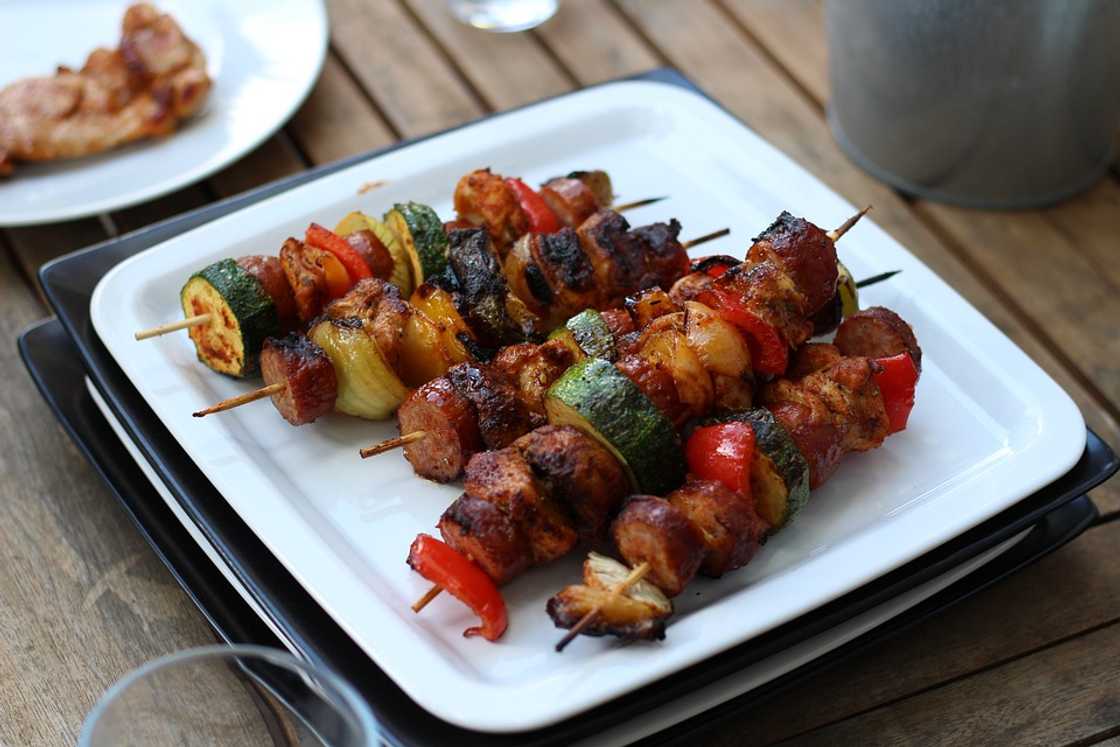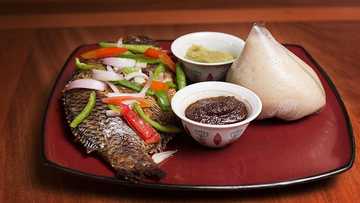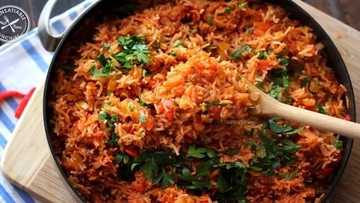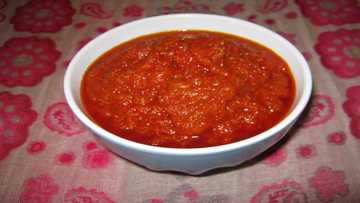Top 15 delicious Ghanaian food recipes for any occasion
Ghanaian food is described by many people as pleasing, savoury, and healthy. It mainly consists of spicy soups and stews made of onions, tomatoes, ginger, pepper, and many indigenous spices. Many dishes are relatively easy to make. You require locally sourced ingredients and traditionally made seasonings to create yummy dishes.
PAY ATTENTION: Сheck out news that is picked exactly for YOU ➡️ find “Recommended for you” block on the home page and enjoy!

Source: UGC
Similar to other West African nations, Ghanaian food features a starchy staple accompanied by a soup or sauce. The soup contains vegetables and proteins. Many dishes are quite spicy.
Delicious Ghanaian food to try this festive season
Below are local Ghanaian dishes you should try soon. They are nutritious, delicious, and suitable for all household members.
1. Banku

Source: UGC
PAY ATTENTION: Enjoy reading our stories? Join YEN.com.gh's Telegram channel for more!
Many Ghanaian dishes have Banku as the main starch. Banku is one of the national dishes of Ghana. It originated from the Ga-Adangme people, mainly found on the South Eastern coast of Ghana.
This dish has a sour taste due to the fermentation of corn dough. Banku goes well with okro stew, grilled fish, shito, and shitor din. Check out how to prepare Banku below.
Ingredients
- 1½ cups fermented corn dough
- 2 cups of cassava dough
- 1 tsp salt for taste
- 2 cups of water
Instructions
- Mix 1 cup of water and cassava dough in a pan. Pour the mixture through a sieve to remove any residue or unmilled pieces of cassava.
- Add the corn dough to the cassava dough.
- Add the salt and mix thoroughly until the mixture becomes thin and smooth. Put the mixture in a cooking pot.
- Place the cooking pot over medium fire and continue stirring. The banku will harden as it continues to cook. Continue stirring the mixture to avoid the formation of lumps.

Source: UGC
- Add about one cup of water to the mixture as you continue stirring. Next, cover the pot for 5 minutes to allow the Banku to cook. You can turn it over a few times to ensure even cooking.
- When ready, shape it into a small ball using a spoon. Alternatively, scoop the preferred amount into a wet bowl and swirl around to form balls.
- Serve with okro stew or grilled fish with a side of salsa.
2. Kontomire stew
Kontomire stew, also known as ebunu ebunu, is one of the local Ghanaian dishes. It is a delicious Ghanaian soup made from cocoyam leaves that give it a characteristic green colour. Kontomire stew can be served with fufu, rice, or boiled ripe plantains and is prepared as explained below.
Ingredients
- 15 Kontomire leaves
- 4-6 medium tomatoes
- ¼ cup turkey berries (optional)
- 3 medium onions
- Pepper to taste
- 2 medium smoked salmon
- 1 cup melon seeds
- 1/2 cup of palm oil
- Momoni (optional)
- 2 teaspoons grounded shrimp
- Salt to taste.
Instructions
- Soak melon seeds in water and set aside.
- Next, wash the kontomire leaves under running water to avoid itchy hands. Chop the leaves. Put the chopped kontomire into a saucepan and add a little water.
- Place the saucepan on high heat. Cover the pan and bring it to a boil. Allow to boil for about five minutes before turning off the fire and setting the leaves aside.
- Next, blend two onions, tomatoes, pepper, and turkey berries, and set aside.
- Prepare the salmon by breaking each into two and removing the bones. Cut the flesh into desired sizes, and set aside.
- Wash the soaked melon seeds, drain them, and put them in a blender. Add ¼ teaspoon salt and a little water. Blend into a paste, and set aside.
- Dice the remaining onion on a chopping board.
- Pour palm oil into a medium saucepan and allow to heat.
- Add half of the sliced onions and momoni. Fry until the onions soften.
- Add the blended tomatoes, onions, turkey berries, and pepper, and bring to a simmer on medium heat.
- Add the salmon, salt, and ground shrimp. Cover and let simmer for 7 to 10 minutes.
- Add the blended melon seeds without stirring.
- Cover and reduce heat to low. Allow to simmer for 8 to 10 minutes.
- Gently stir in the steamed Kontomire leaves.
- Add the remaining onions, and allow to simmer for about 5 minutes.
- Turn off the heat and serve with yam, rice, cocoyam, cassava, plantains, or sweet potatoes.
3. Ghanaian chichinga (Suya chicken kabob)

Source: UGC
Chichinga is a common street food made with skewered and grilled meat rubbed with a spice mix known as suya. Suya is a spicy marinade that goes well with any type of meat. If you desire to learn how to prepare Ghanaian dishes, try this chicken chichinga recipe. You can also use your preferred meat.
Ingredients
- 1.5 pounds chicken br*ast fillet, cut into cubes
- 2 tablespoons olive oil
- 2 cloves garlic
- 2 tablespoons grated ginger
- 1 medium onion
- 1 large red onion, diced
- 1 chicken stock cube
- 1 Maggi cube (optional)
- 1 large red bell pepper, cubed
- 1 large green pepper, cubed
- Suya spice
- 2 tablespoons chilli powder
- ½ cup ground roasted peanuts
- 1 tablespoon roasted paprika powder
- 1 tablespoon of garlic salt
- 1 tablespoon onion powder
- Salt to taste
Instructions
- Use your blender to blend the ginger, garlic, onion, chicken stock cube, and olive oil into a smooth paste.
- In a bowl, add the cubed chicken. Pour the blended mixture, mix to coat, and allow to marinate for at least one hour.
- Skewer the seasoned chicken pieces alternating with the peppers and onions and set aside.
- Combine all the ingredients for the suya seasoning and mix well.
- Sprinkle half the seasoning on the skewered chicken and grill the skewers till cooked and browned on both sides.
- Remove from the heat, sprinkle the remaining suya powder, and serve.
4. Palm nut soup
If you wish to try healthy Ghanaian dishes, palm nut soup should be on your list. Besides being healthy, it is one of the tastiest soups enjoyed by people from Ghana, Nigeria, Liberia, Sierra Leon, and Guinea. The marinated meats give palm nut soup or Abenkwan a rich, deep flavour.
Ingredients
- 2-inch piece fresh ginger root
- 1 large shallot
- 1 large plum tomato
- 9 cloves garlic
- 1 teaspoon anise seeds
- 8 ounces oxtails, cut 1 1/2 inches thick
- 8 ounces goat meat, cubed
- 1 large red onion
- 2 tablespoons + 1 teaspoon kosher salt
- 1 can palm cream or palm soup base
- 4 cups water
- 1 habanero pepper (optional)
- 4 ounces dried smoked boneless fish (of your choice)
- 1 tablespoon herring powder
- 1 tablespoon smoked shrimp powder
- 1 bay leaf
Instructions
- Peel and finely chop the fresh ginger, shallot, and 5 garlic cloves. Place them in a mini food processor, add the anise seeds and process to form a paste.
- In a heavy-bottomed pot, add the oxtails, goat meat, 2 tablespoons of kosher salt, and 2 cups of water. Cover and bring to a boil over medium-high heat. Boil until the meat is tender, about 15 to 20 minutes.
- As the meat boils, place the can of palm cream and 2 cups of water in another large heavy-bottomed pan. Stir to combine and bring to a boil over medium-high heat.
- Once the meat is cooked, add the contents of the first pot to the second. Stir to combine and allow to boil until a visible layer of oil has risen to the surface.
- Add the dried smoked fish, herring powder, shrimp powder, bay leaf, and remaining kosher salt. Simmer until slightly thickened, about 15 minutes.
- Peel a large red onion and trim the stem from the habanero.
- Add the remaining 4 garlic cloves, plum tomato, red onion, and habanero to the soup. Continue simmering over medium heat until the vegetables are softened.
- Using a slotted spoon, transfer the garlic, tomato, red onion, and habanero to a blender and blend until smooth. Pour the blended vegetable mixture back into the pot and stir to combine.
- Continue simmering until the meat is very tender and the soup has thickened. There will be a substantial amount of red oil on the surface.

Source: UGC
- Use a spoon to skim off the surface fat. Reserve the fat to prepare a different dish.
- Turn off the heat. Garnish the soup as desired, and serve with your preferred starch.
5. Ghanain okro stew
Okro soup is a very popular local food in Ghana and other west African nations. People enjoy okro stew with Banku or cassava. You can also eat it alone. If you wish to learn how to cook Ghanaian dishes, you can start with this okro stew.
Ingredients
- 1 cup Okra, diced
- 1 pound meat or chicken, cubed
- 2 medium onions
- 4 medium tomatoes, diced
- 4 pieces Kpakpo shito pepper
- 1 inch fresh ginger
- 1 salted fish (momoni)
- 2 cloves garlic
- 1/2 cup herrings
- Crabs (optional)
- Cowhide (Wele)
- 1/2 cup palm oil
- 1 seasoning cube
- Salt to taste
Instructions
- Clean the chopped meat, crabs, and cowhide under running water.
- Wash one onion, garlic, pepper, and ginger. Blend until smooth.
- In a large saucepan, place the meat, crabs, and cowhide. Add some water and bring to a boil. Pour in blended ingredients, reserving 1/4 cup, and boil until tender.
- In a separate pot, place chopped okro. Add a cup of water and let it simmer for about 8 minutes. Turn off the heat and allow it to cool.
- Pour the palm oil into another saucepan and allow it to heat.
- Add sliced onions and cook for about 3 minutes.
- Add reserved blended mixture, and allow to cook for about 5 minutes.
- And the tomatoes, Kpakpo shito pepper, and seasoning cube to the sauce.
- Wash the herrings and take out the bones. Add them to the sauce and let it simmer for about 5 minutes.
- Add the boiled beef, crabs, and cowhide, stir and allow it to simmer for a few minutes.
- Add the cooked okro and stir to mix evenly. Lower the heat and allow the stew to cook for about 10 mins. Adjust the salt and serve.
6. Cassava leaves with dried smoked fish

Source: UGC
Did you know cassava is a tropical, perennial plant? Its roots and leaves are commonly consumed in Africa. Cassava leaves contain a potentially deadly chemical called cyanide, so they must be soaked in boiling water and pounded to remove the chemical. Learn how to prepare cassava leaves with dried smoked fish today.
Ingredients
- 1 bunch cassava leaves
- Boiling water
- 2 spring onions, chopped
- ½ eggplant, peeled and diced
- Celery leaves, chopped
- ½ cup of crushed peanuts
- 1 smoked fish
- 3 tablespoon palm oil
- Salt to taste
Instructions
- Remove the stems of the leaves.
- Place the leaves in a bowl and pour boiling water over them to remove the cyanide.
- Drain and squeeze out any remaining water from the leaves.
- Pound the leaves in a mortar and pestle.
- Place the blended leaves in a cooking pot and add about 200 ml of water.
- Add chopped eggplant, spring onions, celery leaves, and crushed peanuts. Stir the mixture.
- Soak the smoked fish in water for about 10 minutes. Chop it into pieces and add them to the saucepan with the leaves.
- Add salt to taste, followed by the palm oil.
- Mix thoroughly and allow to cook over low heat for 30 minutes. Serve over rice or your preferred starch.
7. Garden egg stew

Source: UGC
Garden eggs are a fruit indigenous to Sub-Saharan Africa. They are similar in nature to purple eggplant or aubergines but have a few distinctive features, including being white in colour. Garden eggs are a popular food in Ghana and are mainly served with boiled plantains.
Ingredients
- 20 garden eggs
- 3 cloves garlic
- 2 medium onions, 1 finely diced and 1 roughly chopped
- 3 tomatoes
- 1/4 cup of tomato paste
- 1 scotch bonnet pepper
- 1/2 red bell pepper
- 1 thumb-sized piece of fresh ginger
- 2 tablespoons red palm oil
- 1 teaspoon bouillon paste
- 2 teaspoons curry powder
- Salt to taste
Instructions
- Clean the garden eggs under running water. Cut the tops, then cut them in halves.
- Place the halved garden eggs in a saucepan, add water, and boil for boil until soft. Set aside to cool down.
- Place another saucepan on medium heat, add red palm oil, and sauté the diced onions. Meanwhile, blend the second onion, garlic, ginger, tomatoes, and bell pepper.
- Add the tomato paste to the sautéd onions and allow to cook for about 2-3 minutes.
- Add the blended mixture and let everything cook down on medium heat for about 10 mins.
- Add the curry powder and the bouillon paste and continue cooking for 10 minutes or until thick. Meanwhile, remove the seeds from the garden eggs (optional).

Source: UGC
- Dice the garden eggs, then add them to the sauce. Lower the heat and let the garden eggs simmer for about 5 minutes to absorb the flavour.
- Turn off the heat and serve with boiled yams or plantains.
8. Kokonte
Kokonte is a starchy staple made of cassava flour. Is closely resembles banku but does not use fermented corn dough. Kokonte is mostly eaten for lunch or dinner. It is often served with groundnut soup, okro stew, palm nut soup, or ground pepper soup.
Ingredients
- 2 cups dried cassava flour
- Water
Instructions
- Pour two cups of water into a cooking pot and bring to a boil.
- Once boiled, fetch some of the water and set aside.
- Add the cassava flour to the boiling water in bits whilst stirring. Continue stirring to avoid lump formation. Stir until it forms a thick and consistent paste.
- Cover and allow to cook for about 10 minutes, turning once or twice for even cooking.
- Use a small bowl to scoop and mould the kokonte into desired sizes.
- Serve hot with groundnut soup or palm nut soup.
9. Ghanaian chicken-groundnut soup
If you wish to learn how to make Ghanaian dishes, you should familiarise yourself with the staple foods and where to source them. A commonly eaten staple is groundnut soup. For a fresh twist, learn how to make Ghanaian chicken-groundnut soup today.
Ingredients
- 2 medium yellow onions, halved
- 2 cups chicken broth
- 5 medium cloves garlic
- 1 hot chilli pepper
- 1-inch knob fresh ginger
- 2 teaspoons tomato paste
- 2 lbs bone-in, skin-on chicken legs
- 1 cup creamy peanut butter
- 2 bay leaves
- 1 can plum tomatoes
- 1 whole smoke-dried fish
- 1 teaspoon freshly ground black pepper
- Kosher salt to taste
Instructions
- In a blender, purée one onion, 1/2 cup chicken stock, 3 garlic cloves, half the fresh ginger, and tomato paste.
- In a heavy-bottomed pot, combine chicken legs with the purée, remaining onion halves, ginger, and garlic. Add the hot pepper and bay leaves. Toss to coat.
- Place the pot over medium heat and bring to a simmer. Cover, reduce heat to low, and cook until halved onion is soft and translucent. Add an extra 1/2 cup of chicken stock if the mixture begins to stick to the bottom of the pot.
- Transfer the onion, ginger, garlic cloves, and hot pepper chunks into a blender. Add peanut butter, canned tomatoes, and 1 1/2 cups chicken stock and purée until smooth.
- Sieve the blended mixture into the pot, stirring to incorporate.
- Increase heat to medium and bring to a boil.
- Lower heat to medium-low to simmer until chicken is tender, the mixture has thickened, and oils have surfaced. Stir occasionally.
- Add the smoked fish, reduce heat to low, cover, and cook an additional 5 minutes.
- Remove and discard smoked fish and bay leaves. Adjust the salt and pepper.
- Turn off the heat and serve hot over kokonte, white rice, or fufu.
10. Kelewele

Source: UGC
Kelewele is a popular Ghanaian food made of fried plantains seasoned with local spices. The dish can be served with or without an accompaniment.
Ingredients
- 6 ripe plantains (not too ripe)
- 1 teaspoon fresh ginger root, grated
- 1 small white onion, diced
- 2 cloves garlic
- 1 teaspoon nutmeg
- 1 teaspoon cayenne pepper
- 1 teaspoon anise seed
- 1 teaspoon of salt
- Oil for frying
Instructions
- Using a sharp knife, cut a shallow line down the length of the plantain and peel back the skin using your hands.
- Slice the plantain into small pieces, about 1 inch in size.
- In a large bowl, add grated ginger, minced garlic, and diced onions.
- Add the cayenne pepper, anise seeds, nutmeg, and salt. Mix well.
- Add the plantain and toss to coat in the spice mix. Allow to rest for 30 minutes.
- Add enough oil to a deep skillet and heat it to 350 degrees F.
- Add a few pieces of plantain at a time to avoid overcrowding the skillet. Allow to fry while turning them to ensure even cooking.
- Use a strainer ladle to remove the fried plantains from the skillet and rest on a plate covered with paper towels to absorb excess oil. Fry all batches.
- Serve hot.
11. Red Red stew
Red red stew is made with black-eyed peas in a rich tomato base. Ghanaian red red stew is delicious and healthy. Depending on your preference, you can add either meat or fish broth for a richer stew.
Ingredients
- 1 1/2 cups dried black-eyed peas
- 1 medium white onion, diced
- 1 green onion, sliced
- 1/4 cup palm oil, divided in half
- 1/2 red bell pepper, diced
- 2 medium tomatoes, diced
- 3 garlic cloves
- 2 teaspoons fresh ginger, grated
- 1/2 cup tomato sauce
- 1 teaspoon curry powder
- 2 bouillon cubes
- 1/4 teaspoon cayenne pepper
- 1/2 teaspoon black pepper
- Salt to taste
Instructions
- Wash the dried black-eyed peas twice and soak them overnight. Drain them and wash them again with water before boiling them until tender. Set aside.
- Heat two tablespoons of palm oil in a large cooking pot. Add the diced onion and cook until they are translucent.
- Add grated ginger, minced garlic, bell pepper, and green onion. Sauté for two minutes
- Add the diced tomatoes, tomato sauce, bouillon cubes, cayenne pepper, curry powder, black-eyed peas, and black pepper. Mix well.
- Let the mixture cook for about 10 minutes.
- To make the stew creamy, use a potato masher to mash black-eyed peas slightly.
- Add two tablespoons of palm oil. Adjust the salt, then turn off the heat.
- Serve with baked or fried plantains.
12. Fufu
Did you know fufu is Ghana's national dish? This starchy dish is normally served with a stew or sauce. Fufu is also widely eaten in other west and central African countries.
Ingredients
- 300g unripe plantain
- 460g cassava
- 1 1/2 - 2 cups water
Instructions
- Peel the plantain and cut it into cubes.
- Peel the cassava, de-string it, and dice it into cubes.
- Place the cassava and plantain into the blender. Add 350 ml water if you want fufu to be firmer or 450 ml if you prefer it softer. Process the ingredients into a smooth paste.
- Put the paste in a cooking pot and place it over medium heat. Stir constantly with a wooden spoon for 8 to 10 minutes to avoid lump formation.
- Add another 50 ml of water to the mixture.
- Reduce the heat to the lowest setting, cover with a lid and allow to cook for another 8 to 10 minutes.
- Next, increase the heat to a medium setting and stir. The fufu might look overly soft, but it will become firmer as it cools down.
- Transfer the fufu into a bowl and sprinkle one teaspoon of water on its surface. This will prevent the formation of a film. Let it cool completely.
- Shape fufu into a ball and serve with your preferred soup or stew.
13. Waakye
You can have waakye for lunch, brunch, or dinner. Waakye is a simple dish of rice and beans cooked with red sorghum leaf sheaths called waakye leaves. Below is how to prepare it.
Ingredients
- 2 cups rice
- 1 cup black-eyed beans
- 6-8 waakye leaves
- Salt to taste
- Water
Instructions
- Sort the beans and wash them. Place them in a pressure cooker.
- Wash the waakye leaves and add them to the pressure cooker. Add water and pressure cook until the beans are fully cooked (about 15 minutes).
- Turn off the heat and allow it to depressurise for about 20 minutes. Once all pressure is out, unlock the lid.
- Pour the beans with the waakye leaves and cooking liquid into another pot. Wash the rice and add it to the pot. Add more water, if needed, so there is enough to cook the rice. Add some salt and cover the pot.
- Turn on the heat and allow the rice to cook.
- Turn off the heat, remove the waakye leaves, and serve hot. Many people serve waakye with beef stew.
14. Ghanaian Jollof rice

Source: UGC
Jollof rice is a one-pot rice dish popular in West Africa. Jollof rice cooks in a rich and spicy tomato-based sauce, giving it a bright red or orange colour. It is commonly served at weddings, parties, and other large social or formal gatherings.
Ingredients for the meat
- 800g lamb or beef
- ½ an onion
- 1 scotch bonnet pepper
- 1 bouillon cube
- 3 whole cloves
Ingredients for the rice
- 2 cups long-grain rice
- 1 large onion, diced
- 4 tablespoons oil
- 2 cloves garlic, minced
- 1 inch fresh ginger, grated
- 1 scotch bonnet pepper, chopped
- 1 tablespoon tomato puree
- Salt to taste
- 6 large tomatoes (fresh), diced
- 1 seasoning cube
- ½ cup mixed carrots and peas
- 1 teaspoon thyme
- 2 cups hot water/stock/ broth
- Parchment paper
Instructions
- Cut the meat into sizeable chunks.
- Blending ½ portion of onion and the bouillon cube. Rub the paste on the meat.
- If the meat is tough, simmer it until tender.
- Remove the pieces of meat from the broth and grill or fry them to make them crisp. If the meat is tender, grill it directly. Set the cooked meat aside.
- Take a heavy-bottomed pan, turn on the heat, and add the cooking oil.
- Add the diced onion and fry until golden.
- Add the garlic and ginger and stir for a few seconds.
- Add the tomato puree or paste and fry for under a minute.
- Add the thyme, bouillon cube, tomatoes, and scotch bonnet pepper.
- Cook the sauce for about 15 to 20 minutes. Stir continuously to prevent burning.
- Add the meat and stir to coat it well with the sauce. Allow the stew to continue cooking. Meanwhile, rinse the rice and soak it in hot (boiled) water.
- Once the stew thickens and forms an oily film on the surface, remove half the meat stew from the pot and set aside.
- Strain the soaked rice and add it to the pot. Adjust the salt and seasoning.

Source: UGC
- Add enough broth or water to cook the rice. Bring to a boil, then lower the heat to simmer.
- Add the peas and carrots when the moisture has nearly gone.
- Cover the pot with parchment paper to lock in moisture and add natural cooking pressure. Next, close the pot with an airtight lid and reduce the heat to low. Allow to cook gently for 20 minutes.
- Note the bottom of the pot will have a layer of caramelised Jollof with concentrated flavour. Take off the heat, and serve hot with the beef stew you set aside earlier.
15. Etor
Etor is a traditional yam purée enriched with palm oil. It can also be made of plantain purée. This dish is from Ga and Akan regions. Also called otor, it is considered a sacred and celebratory dish in Ghana.
Ingredients
- 4 yams
- 4 hard-boiled eggs, halved
- 2 onions , julienned
- 4 tablespoons palm oil
- 4 tablespoons roasted peanuts
- 1 ripe avocado
- Pepper
- Salt to taste
Instructions
- Peel and boil the yams in salty water.
- Once tender, drain the yams. Use a potato masher to mash them.
- Add the palm oil into a saucepan and turn on the heat.
- Add the onion and sauté it until golden brown.
- Take ¾ of the golden onions and the palm oil and add them to the mashed yam. Mix thoroughly.
- Garnish with peanuts, the remaining onions, hard-boiled eggs, and avocado. Serve.
What is the most popular dish in Ghana?
The most popular starchy staples are cassava and plantain. Chicken, beef, and chevon are the commonly consumed meats.
What is Ghana's national dish?
Fufu is Ghana's national dish. Many households eat it daily. It is mainly served with a soup or stew.
What is a typical breakfast in Ghana?
A typical breakfast is made of koko with koose. Koko is a hot and spicy millet porridge, while koose refers to fried bean fritters.
Ghanaian food is quite spicy and savoury. The cuisine may vary from one part of the nation to another. Some dishes take a short period to cook, while others take much longer.
READ ALSO: Here is how to prepare sobolo drink with pineapple in Ghana
Yen.com.gh recently published how to prepare sobolo drink with pineapple in Ghana. Consuming homemade health drinks is encouraged because it nourishes the body with vitamins, minerals, and other phytonutrients.
Sobolo is one of the healthy drinks commonly consumed in Ghana. It is made from dried and crushed rosella or hibiscus flowers.
New feature: Сheck out news that is picked for YOU ➡️ find “Recommended for you” block on the home page and enjoy!
Source: YEN.com.gh

Julian Mireri (Lifestyle writer) Julian is a content creator who has been working with Yen since 2018. She graduated from the University of Nairobi with a Bachelor’s Degree in Project Planning and Management in the year 2013. Think of her as a content whisperer and a gifted storyteller who never disappoints when it comes to finding the right words for her pieces. Email: julianmireri@gmail.com

Cyprine Apindi (Lifestyle writer) Cyprine Apindi is a content creator and educator with over six years of experience. She holds a Diploma in Mass Communication and a Bachelor’s degree in Nutrition and Dietetics from Kenyatta University. Cyprine joined Briefly.co.za in mid-2021, covering multiple topics, including finance, entertainment, sports, and lifestyle. In 2023, she finished the AFP course on Digital Investigation Techniques. She received the 2023 Writer of the Year Award. In 2024, she completed the Google News Initiative course. Email: cyprineapindi@gmail.com
















